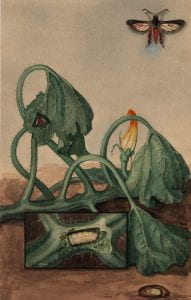 By Kimberly Marshall, Washingtonville Master Gardener Volunteer
By Kimberly Marshall, Washingtonville Master Gardener Volunteer
This article appeared in the June 2021 Issue of Gardening in Orange County.
Nothing feels worse than seeing your squash wilt and die—especially after months of watching those leafy green beauties thrive in your garden.
Although the culprit may be many things, it often turns out to be the squash vine borer (Melittia cucurbitae)—an odious insect that nestles into the squash’s stem. Whilst making a lovely home for itself, it chokes off the plant’s nutrients and kills those crops you’ve so carefully chosen, planted, and reared.
To prevent the squash vine borer from damaging your harvest, here’s how to recognize and eliminate the pest.
 How to identify the squash vine borer and the damage that it does:
How to identify the squash vine borer and the damage that it does:
Look for
- black moths with orangey-red markings on the head, legs, and abdomen
- flat eggs resembling tiny brown ovals around the plant’s base
- fat, white, wrinkly, worm-like larvae at the base of the stem
- wilting leaves and rotting stems
- holes at the base surrounded by “frass” (which looks like sawdust)
How to prevent squash vine borers from ruining your yield:
- rotate your crops (as borer cocoons overwinter in the soil)
- clear away squash plants immediately after harvesting, removing any and all plant debris
- use row covers early in the growing season (must be removed to allow for pollination), or protect stem bases by wrapping them in aluminum foil
- grow borer-resistant varieties, such as ‘Cocozella di Napoli’ or ‘Costata Romanesco’. Butternut squashes are also highly resistant.
- plant extra—just in case.
 How to minimize damage if borers have found your garden anyway:
How to minimize damage if borers have found your garden anyway:
- plant the pest’s preferred crop—Hubbard squash—as a ‘trap crop’
- fill a yellow dish or bucket with water to attract moths. While this won’t totally divert them from the plants, it will provide an indication of their presence so you know to be extra vigilant about looking for eggs
- if you notice frass, immediately cut lengthwise up the squash’s stem, remove all of the larvae, and then bury the cut in nutrient-rich soil to re-root.
In general, you should look for the squash vine borer early and often. After all, it’s always better to be a safe gardener than a sorry one!
